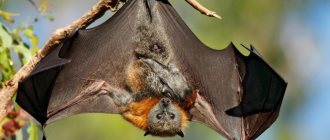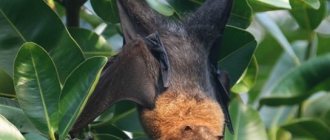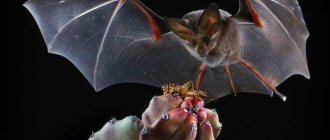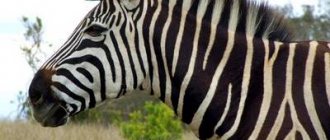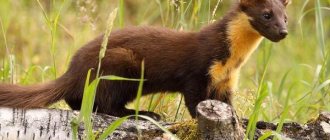- Wild animals
- >>
- Mammals
Flying foxes are nomadic mammals that travel across large areas of Australia, feeding on local flowers and fruits, dispersing seeds and pollinating native plants. Flying foxes are not related to foxes, but are a group of bats with fox-like heads.
Origin of the species and description
Photo: Flying fox
Flying foxes (also called fruit bats) are members of a large group of mammals called bats. Bats are the only group of mammals capable of long flight.
Old World fruit flying foxes (family Pteropodidae) live in large groups and eat fruit. Therefore, they are potential pests and cannot be imported into the United States. Like almost all Old World fruit bats, flying foxes use vision rather than echolocation to navigate.
Video: Flying fox
Among the most famous pteropodids is the flying fox (Pteropus), found on tropical islands from Madagascar to Australia and Indonesia. These are the largest of all bats. Some of the smallest members of the Family feed on pollen and nectar from fruit trees.
Long-tongued flying foxes (Macroglossus) have a head and body length of about 6–7 cm (2.4–2.8 in) and a wingspan of about 25 cm (10 in). Color varies among pteropodids; some are red or yellow, some are striped or spotted, with the exception of bats (Rousettus).
Asian members of the Family include various spout-nosed flying foxes and short-nosed fruit flying foxes (Cynopterus). African members of the Family include the epaulette flying fox (Epomophorus), in which males have characteristic tufts of pale hair on their shoulders, and the hammerhead fruit flying fox (Hypsignathus monstrosus), which has a large, blunt snout and pendulous lips.
Appearance and features
Photo: What a flying fox looks like
There are 3 types of flying foxes:
- black flying fox;
- grey-headed flying fox;
- little red flying fox.
The black flying fox (Pteropus alecto) is almost entirely black with a small rusty red collar and a light silver-gray glaze on the belly. They have an average weight of 710 grams and are one of the largest bat species in the world. Their wingspan can be more than 1 meter.
The grey-headed flying fox (Pteropus poliocephalus) is easily identified by its rusty, reddish collar, gray head and hairy feet. It is an endemic mammal and the largest Australian flying fox. Adults have an average wingspan of up to 1 meter and can weigh up to 1 kilogram.
It is also the most vulnerable species because it competes with humans for prime coastal habitat along south-east Queensland, New South Wales and the Victorian coasts. The grey-headed flying fox is the only species of flying fox continuously present in South Australia and is a nationally critically endangered species.
Weighing 300-600 grams, the little red flying fox (Pteropus scapulatus) is the smallest Australian flying fox and has a tan-colored coat. Small red flying foxes often fly much deeper than others.
Habitat
Flying foxes live in tropical and subtropical forests of Thailand, Malaysia, Vietnam, Laos, the Philippines, Hindustan, New Guinea, Australia, Oceania, Madagascar and some other nearby islands. Flying dogs can be found in the tropics and subtropics of South and Southeast Asia. Due to their feeding habits, the natural habitat for these animals is dense forests with an abundance of fruit trees, especially mango and eucalyptus thickets. Sometimes fruit bats can be found in mountainous areas at an altitude not exceeding 1200 meters.
Where does the flying fox live?
Photo: Bat fox
Flying foxes can use most habitat types that provide food, especially eucalyptus forests. With adequate flowering and fruiting trees, bats will not hesitate to fly into cities and towns, including central business districts.
Interesting fact: Flying foxes are quite social animals, forming huge roosts, sometimes several thousand strong. These are very noisy and smelly places where neighbors constantly quarrel over their small territories.
Large groups of 28cm tall fruit-eating grey-headed flying foxes are no longer rare sights in several Australian cities, including Melbourne. Over the past few decades, the expansion of new urban food sources and the development of bats in rural homes have made cities their main residence. This migration has been a mixed blessing for the flying foxes, which face threats from urban infrastructure such as nets and barbed wire, as well as persecution from residents.
The black flying fox is distributed in coastal and coastal areas of northern Australia from Shark Bay in Western Australia to Lismore in New South Wales. It has also been found in New Guinea and Indonesia. The grey-headed flying fox's traditional habitat lies 200 km off the east coast of Australia, from Bundaberg in Queensland to Melbourne in Victoria. In 2010, many gray-headed flying foxes were found living in these traditional areas; some have been found as deep inland as in Orange, and as far south-west as in Adelaide.
Little red flying foxes are the most common species in Australia. They occupy a wide range of habitats in northern and eastern Australia, including Queensland, Northern Territory, Western Australia, New South Wales and Victoria.
Now you know where the fox bat lives. Let's see what this fruit bat eats.
What does a flying fox eat?
Photo: Giant flying fox
Flying foxes are often considered a pest by fruit gardeners. However, the truth is that they prefer their natural diet of nectar and pollen from flowering native trees, especially eucalyptus and fig trees, although local fruits and berries are also consumed. When forests are cleared, flying foxes lose their food source and are forced to resort to alternatives such as an orchard.
Grey-headed flying foxes are nocturnal foragers of flowering and fruiting plants. They find these foods using a strong sense of smell and large eyes suitable for recognizing colors at night. Flying foxes return to the same resources every night until they are depleted. Their diet is varied and they can feed on the remains of native vegetation as well as in urban areas. They may also exploit new resources, including the fruits of cultivated trees, especially when their preferred food resources are limited.
Fun Fact: Grey-headed flying foxes prefer to feed within 20 kilometers of their habitat, but can also travel up to 50 kilometers in search of food.
Flying foxes are beneficial to vegetation health as they disperse seeds and pollinate native plants. Researchers speculate that flying fox migrations may be related to food scarcity, nectar flows, or seasonal fluctuations.
These animals, which eat fruits, flowers, nectar and roots, are key to plant pollination and seed dispersal. In fact, they can fly long distances - more than 60 km in a single night - bringing fruit (and seeds) with them and even collecting seeds as they fly. The fruits are unlikely to survive unless their seeds can travel far enough from their mother plants, so flying foxes ensure their dispersal.
Features of character and lifestyle
Photo: Flying fox in the Maldives
Flying foxes are increasingly moving into urban areas in search of food and shelter as a result of the loss of their natural habitat. This can sometimes be problematic for local residents due to concerns about the health and welfare of the flying fox camp.
A familiar sight to much of eastern Australia, grey-headed flying foxes, or fruit bats, are usually seen at dusk, leaving their roosting areas in large groups and heading towards their favorite feeding grounds. Because the gray-headed flying fox is listed as a threatened species in New South Wales, a permit is required to move the foxes.
Fun fact: The main scent associated with flying foxes is the scent of male flying foxes, used to mark their territory. Although this odor may be offensive to some people, it does not pose a risk to human health.
Noise can be a problem when flying fox roosting sites are located near residential or business areas or schools. When flying foxes are stressed or scared, they make a lot more noise. Colonies tend to be noisiest when disturbed by humans and quietest when left alone.
Flying foxes are active at night when flying long distances in search of food. If your home is in the flight path of flying foxes, it may be affected by droppings. Droppings from many animals, including flying foxes, can end up on roofs.
Flying foxes in captivity
Wild fruit bats can be found in outdoor zoos or botanical gardens. If, when living in freedom, the lifespan of flying dogs rarely reaches 15 years, then in captivity, with proper care, the duration of existence doubles. Cute faces and good disposition have attracted the attention of lovers of exotic pets to flying foxes. To keep a fruit bat at home, you will need a very spacious enclosure.
Relationships with a person
The flying fox easily gets used to communicating with people if it feels a favorable attitude on their part. A fruit bat can allow itself to be stroked by a person who has gained its favor. They happily accept treats from people, such as bananas, apples, avocados and other fruits. A conflict can only arise when fruit bats attack plantations with cultivated crops. At the same time, the winged foxes themselves suffer due to poisoning with pesticides. Flying dogs are of interest to people for their meat, and their fat is used for medicinal purposes.
Social structure and reproduction
Photo: Flying fox in flight
Flying foxes do not reproduce quickly. Female flying foxes become fertile at two or three years of age and usually only have one baby each year. This makes it difficult for the population to recover in the event of massacres. Bat camps are critical sites for mating, birth, and raising of young. Grey-headed flying foxes can mate throughout the year, but conception usually occurs between March and May, when males become fertile.
Pregnancy lasts six months and females give birth to a single calf between September and November. The cub clings to its mother's belly and is held for three to five weeks before being left at night in a bat nursery camp. Mothers return to camp just before dawn, find their young using unique signals and scents, and nurse it. Mothers wrap their wings around their young to protect them during the day and in cold temperatures.
The cubs are weaned after about five months, and after some practice flying around the camp, they fly out at night with the adults to feed on flowers and fruit. Juveniles learn to fly after about two months and become fully independent after the next month. Independent juveniles are accident prone and mortality rates are high during the first two years of life.
Offspring
Each year, the female of this species of animal can bear no more than one cub. She carries the future cub for six months. As a rule, cubs are born in the spring. As soon as the baby is born, the mother carries it with her for the first weeks. Then she leaves him alone on a branch, and only after that she returns to him to teach him to fly. It takes her a couple of months to create a new full-fledged member of the flock, who will fly along with everyone else and get food for herself.
Natural enemies of flying foxes
Photo: Black flying fox
There are many different predators that can cause problems for flying foxes. The size of different species affects what types of problems they may face with different predators. Some species of flying animals find the flying fox a tasty meal. These include owls and hawks. Owls can often be seen capturing bats while flying. They can go unnoticed, and when flying foxes fly by, they are consumed without any warning.
The main predators of flying foxes are:
- owls;
- hawks;
- snakes;
- spiders;
- minks;
- raccoons.
Snakes are a common predator of flying foxes, which consume fruit. Snakes can easily blend into trees and plants where such fruits grow. These snakes can range in size from small to quite large. They tend to be more of a problem in warmer climates. Flying fox areas tend to have a lot of problems with snakes.
In some areas, raccoons and weasels have been identified as predators of flying foxes. They often hide in areas where flying foxes sleep. They wait for them when entering or leaving this place. Spiders called tarantulas can also kill small species of flying foxes. Minks have also been identified as predators of flying foxes in some locations.
In some areas where flying foxes live in trees, there have been reports of them being captured by domestic cats. They do not usually consume flying foxes, but can kill them and even play with them. In fact, many people have discovered that they have flying foxes after their cat brought one home or was spotted playing with one outside.
The biggest predator of flying foxes is humans. Most people are afraid of them and consider them dangerous rodents. The fact that a flying fox colony can grow very quickly is another cause for concern. The risk of bats spreading disease is also a concern for people. They hear about rabies and other possible health problems. People are also concerned about the effects of flying fox urine and feces, so they often set up flying fox traps.
Population and species status
Photo: What a flying fox looks like
There are 65 species of flying foxes in the world, and about half of them are threatened with extinction. Flying foxes face threats from habitat loss and mass hunting for their meat or sport hunting. This situation is not good for island ecosystems and, ultimately, for the people who live there. Many fruit growers also believe that flying foxes are bad because mammals eat their fruit; therefore, several governments approve the mass killing of flying foxes. In 2015 and 2016, on the Indian Ocean island of Mauritius, the government killed more than 40,000 flying foxes in a mass eradication campaign, although the native species, Pteropus niger, is considered vulnerable to extinction.
Outside the city, developers are removing plants that flying foxes feed on as rural areas are increasingly converted to farmland and housing estates or cut down for timber. If the destruction continues, the population will have fewer and fewer food options, making habitat destruction a major threat to the species.
Global warming is putting pressure on the flying fox population. On very hot days, flying foxes can die from heat stress, a condition they signal by clumping together and sliding slowly down tree trunks in a fluffy mass. If there is a heat wave in the spring and the babies are still completely dependent on their mothers, it can kill the offspring for almost an entire year.
The national monitoring program for the gray flying fox in Australia began on 14 February 2013 and is carried out every three months. This is the largest census of grey-headed flying foxes ever conducted throughout the species' national range. The purpose of the census is to provide reliable monitoring of current flying fox population numbers in 2013 and to monitor future population trends.
Notes
- Sokolov V. E. Five-language dictionary of animal names. Mammals. Latin, Russian, English, German, French. / under the general editorship of academician. V. E. Sokolova. - M.: Rus. lang., 1984. - P. 49. - 10,000 copies.
- Pavel Kotlyar. Flying foxes have mastered oral sex (Russian). Gazeta.ru (04/06/2013). Retrieved February 5, 2016.
